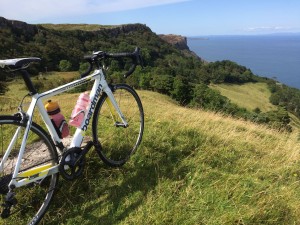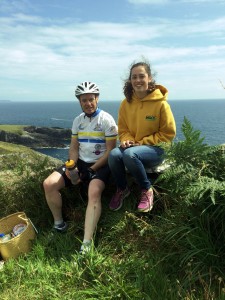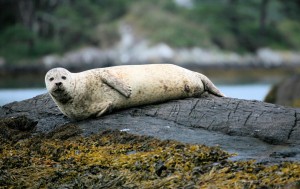Ireland has a unique and special natural heritage. The combination of plant and animal communities it supports are found nowhere else on earth, and the diverse landscape is of great natural beauty. Yet in the general media, the conservation of Ireland’s special wildlife and landscape is rarely presented in a concrete, real way or celebrated in a positive manner. As a personal effort to change the image of nature conservation in Ireland, I cycled around the coast of Ireland for the month of August, a distance of about 3,200km, each day visiting some of Ireland’s special wildlife sites and meeting up with people who have a story to tell about their locality. I called it the Wild Ireland Tour. By cycling you see the wonderful landscape with your eyes, and feel the unfolding terrain in your legs.
Murlough Bay Nature Reserve, Northern Ireland
Another personal dimension to the trip was being accompanied by my 18 year old daughter, Bella, who drove support car and looked after all the logistics for the trip for the month. Bella just completed her second-level education and one of my challenges was to communicate to her my love of wildlife. Having a whole month with my daughter during her formative years and sharing with her what I saw, and the people I met, was special.
Setting off from Waterford on the 1st August, I wasn’t quite sure what to expect. I had a detailed itinerary which would see me cycle an average of 130km on each of the 26 days cycling during the month of August. I had also arranged to meet about 40 people at sites right around the coast of Ireland. Some I knew professionally, others I was meeting for the first time. But I was a bit taken aback by the huge amount of enthusiasm that I received from everyone I approached about the Tour. All thought it a great idea, and everyone was more than pleased to have the opportunity to talk about their interest and to demonstrate the passion they have for their subject.
Liam and Bella Lysaght, Brow Head, Co. Cork
It is impossible really to identify what were the highlights of the Tour, for the whole trip was a series of highlights, each of a different quality. And almost at every turn, the coast of Ireland has something special to offer, each with a unique character. Sitting on a pleasant verdant headland at Galley Head in Cork watching Fin Whales just offshore, was in marked contrast to the wilder, more rugged headland at Malin Head in Donegal, on the lookout for Basking Sharks. Sand dunes were a constant habitat along the coast, yet the magnificent dune system at Inch in Kerry, hardly bore any relationship to the well vegetated dunes at Murlough Bay in Co. Down. The semi-natural grasslands of the Burren in County Clare were an entirely different setting to similarly rich grasslands at Bunbeg, just adjacent to Carrickfinn in Donegal, yet they shared many of the same specialist species. And the shallow inlets and bays of Cork and Kerry contrasted with the more sheltered bays of counties Down and Louth.
And standing overlooking Annagh Marsh on the Belmullet Peninsula in County Mayo watching wetland birds flying overhead and hearing about the conservation measures there to conserve the breeding birds the site supported, seemed like a million miles away from Bull Island, in the heart of Dublin City. But Bull Island supports internationally important concentrations of wetland birds, and it too requires special conservation measure to conserve its biodiversity interest. Yet, the management issues at both sites could hardly be more different.
Common seal, Garnish Island, Co. Cork
But there are two messages that I will take from this journey, one relates to the wonderful landscape we have, and the other to lessons for nature conservation.
The Wild Ireland Tour took me through some of the most special landscapes and natural heritage sites in Europe. But no matter how stunning these areas are, without having people to share their knowledge and passion for their locality, and to serve as champions for nature, these places remain fairly sterile, inert areas. Yes, one can certainly be moved by the awesome power of waves breaking on the shore, or feast on the kaleidoscope of colours of a hillside, but it is only by seeing localities through the lenses of people who care that places come alive and are imbued with character. Certainly investment in marketing and infrastructure is needed to unlock some of the value in our special landscape, but investment in people who can unlock the knowledge of the landscape is far more important if we are to gain the full benefits of our unique natural heritage. I don’t think this absolutely fundamental point has even begun to be appreciated by decision-makers.
For this to happen, it requires a paradigm shift from viewing nature conservation as an impediment to economic growth to availing of the opportunities that the conservation of biological diversity presents as a mechanism for rural regeneration. The unequivocal and proactive commitment to science-based nature conservation, with its concomitant investment in scientific survey, monitoring and assessment, and locally led conservation management and interpretation could transform Ireland’s rural economy. A transformation that would be based on Ireland’s wonderful natural resources, high quality rewarding employment, and the potential for significant downstream economic benefits. It would provide the mechanism for unlocking the estimated €2.6 billion that biodiversity contributes to the Irish economy each year.
I also realise that those of us who have an interest and appreciation of the rich biodiversity of the country are a fortunate lot. The differences that separate one grassland type from another, or one woodland habitat from the next, are subtle, nuanced differences. We are privileged to be able to view the countryside through this prism of detail, but we must understand that this is a world invisible to many. If we are to build a greater constituency for nature conservation we have to look at ever more novel ways to communicate the value of biodiversity, and break down the barriers that have become established between conservationists and the rest of society. How we do this, I’m not sure, but do it we must.
Dr. Liam Lysaght is Director of the National Biodiversity Data Centre in Waterford, Ireland.
For more about his Wild Ireland Tour, see www.wildirelandtour.ie





No comments yet, add your own below